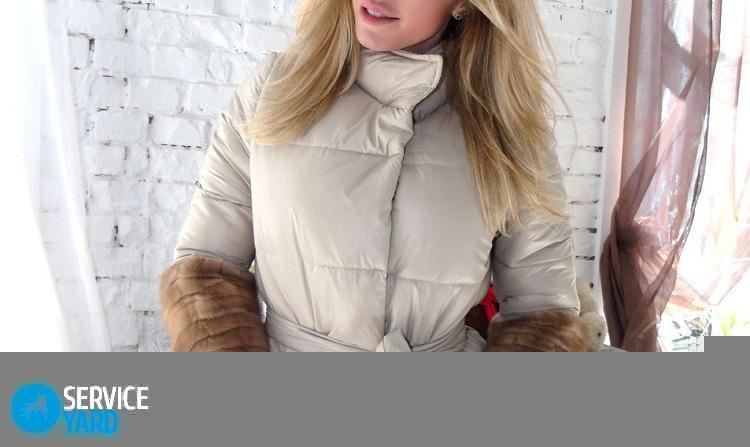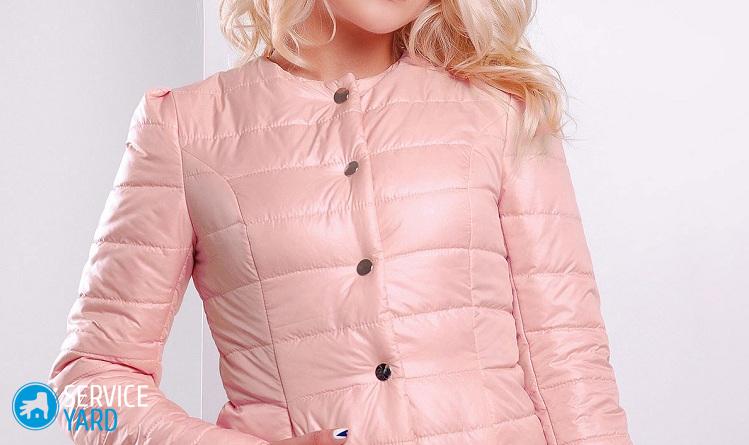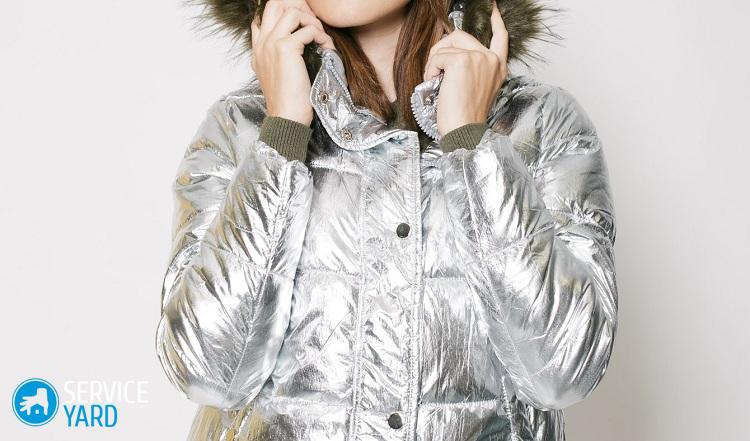How to sew a jacket?

Now in trend quilted jackets. During the autumn-winter cold season, quilted items are indispensable clothing. Even during severe frosts in a quilted coat you feel comfortable. Having the necessary sewing skills, any needlewoman is able to create a unique product that will be unique in its own way. In our article, we will consider how to sew a jacket of such a model yourself.
to contents ↑Tools and materials
To make a quilted jacket, you must first prepare the following tools and materials:
- jacket quilted material with a length of 1.5 cm (all data correspond to 44 size);
- lining material about 1.5 cm in length; twill fabric and 100% can be used polyester;
- long zipper for fastener - 1 pc .;
- twisted zipper for the hood - 1 pc.;
- short lightning - 2 pcs.;
- elastic braid with elastic property;
- sewing threads of the corresponding color scheme;
- sewing machine;
- sewing pins;
- needle with thread:
- chalk for cutting;
- tape measure.
Model selection
The choice of a model of a jacket with a hood is not random:
- a very convenient removable hood, while you can easily change the style by designing the jacket with a beautiful scarf or an interesting stole;
- the hood is a convenient and versatile part of the jacket, while by transforming the hood and accessories, you can create unique images for any style.
Design Features
- The bottom of the jacket, the edges of the hood, the lower part of the sleeves and pockets are treated with elastic braid, which, while tightening the material, preserves the natural air circulation under the jacket.
- The front of the jacket has a zipper and a hidden zipper.
- There are four pockets on the jacket in reliefs - two upper chest pockets that are fastened with zippers, and two lower sewn pockets.
- We will make a jacket with a raglan sleeve, which is perfect for creating models designed for outdoor activities.
Preparation for cutting
Before cutting the material, the fabric is usually rolled. If you use material on a synthetic winterizer, then it does not need to be ironed. In this case, the lining material needs to be rolled out. The fabric should be steamed with an iron or moistened with warm water, allowed to dry, and then ironed.
to contents ↑Open jackets
How to sew a quilted jacket on a synthetic winterizer with your own hands using a pattern? When cutting a jacket, it is necessary to cut the following blanks from the main fabric:
- shelf - 2 pcs.;
- back without middle seam;
- sleeves - 2 pcs.;
- hood.
We cut out the details of the lining according to the finished blanks, while not forgetting to leave an allowance of about 1 cm on the free fit in the center of the back.
Without fail we take into account processing allowances:
- side seams 1.5-2.0 cm;
- sleeve seams and reliefs 1.5-2.0 cm;
- shoulder seams, edges of the sides 1.0-1.5 cm;
- sleeves and armholes 1.5 cm;
- neckline 1.0 cm;
- the bottom of the jacket and sleeves is 1.0 cm;
- connection seams for the hood 1.5 cm;
- the bottom of the hood is 1.0 cm;
- the outer section of the hood is made without allowance.
Jacket fitting
On the shelf and back we grind the reliefs. On the sleeves we make out shoulder tucks. We sew sleeves into armholes. After that, we connect side seams and seams on the sleeves with a single line. Then we make the hood blanks.
We are trying on a future thing:
- Put on a jacket and sewing pins in the center
- We draw attention to the location of the shoulder seam, which should not go either forward or backward.
- If necessary, we adjust the raglan line, specify the length of the jacket and sleeves.
- On the shelf on the reliefs, we note the location and depth of the pockets.
- If necessary, we deepen the neck and pin the hood with sewing pins.
- We pay attention to the shape, size and depth of the hood.
- If necessary, we change the volume, using side seams, reliefs and seams on the sleeves.
- Once again, carefully evaluate the appearance of the thing.
to contents ↑Important! Changes made to the product with sewing pins are marked with chalk. After removing the pins, chalk marks remain, according to which changes are made after the first fitting.
Tailoring jackets
We grind the reliefs on the workpiece, taking into account the changes made. On the front side, we lay the finishing stitches at a distance of 0.2-0.5 cm from the seam.
Let's consider how to make a pocket with a zipper on a jacket.
To do this, prepare:
- burlap, consisting of two blanks;
- zipper - one piece.
How to sew a jacket from quilted fabric with your own hands:
- We connect the blanks of the burlap, while departing 1.5 cm from the sections of the entrance to the pocket.
- On the shelf we grind the relief, while leaving free space for the chest and lower pockets.
- In the form of triangles we make notches, not reaching 0.2 cm to the lines.
- From the wrong side, we sew a zipper into the seam of the relief, while we try to adhere to the following recommendations:
- the marking line should not be located with the alleged seam of the relief of the product, while it passes half the teeth of the lightning;
- as a result, in the finished form, the zipper evenly lies in the seam of the relief, while there are no creases both at the beginning and at the end of the zipper, a similar method resembles the design of a seam in a frame.
Important! Stitch lightning into relief using a special foot. At the same time, the pocket is obtained as high quality as the line goes close to the zipper.
- From the wrong side to the lightning allowances we sweep the burlap of the pocket using the special foot.
- In a split, we pocket an edging.
- We pocket the finishing line, while we try not to catch the burlap.
- In exactly the same way on the second half of the shelf we process the pocket.
How to make a pocket on a jacket in a seam?
In order to make a pocket in the seam of the jacket, you should do some actions:
- On the shelf blank we draw an arcuate line to enter the pocket.
- We procure the details of the burlap and the clearance.
- We connect the gap to the burlap.
- We chop and grind burlap details.
- We connect the burlap to the product with an open seam.
- With elastic braid, we process the slice of the entrance to the pocket in two stages:
- from the wrong side we sew one side of the braid, while pulling the braid a little to form assemblies on your pocket;
- we bend the braid to the front side, bend the cut and sew the second side of the ribbon.
- With a pocket we grind a relief seam.
Important! To strengthen the entrance to the pocket, you can put vertical machine braces on the wrong side.
- On embossed seams, we lay the finishing lines.
- In the starting and at the end point of the pocket with a zipper we set the fasteners.
- You can use applications in the form of triangle amplifiers.
Raglan sleeve connection to the product
Let's consider how to sew do-it-yourself raglan sleeves for a jacket on a synthetic winterizer:
- On the sleeves we grind the shoulder seams and fasten the allowances with finishing lines.
- We sew sleeves into open armholes.
- At the junction of the sleeves with armholes at the allowances on the wrong side, we make cuts.
- We lay out allowances in different directions and lay the finishing lines at the seams.
- Stitch side seams and seams on the sleeves, while laying a single line.
- We estimate that all seams and cells of quilted material coincide with each other.
- In different directions we gently iron the allowances - it is better to use a low temperature iron without using steam, while slightly pressing the iron.
Jacket jacking on synthetic winterizer
After stitching the sleeves in the armholes, we proceed to the procedure for the necking, if necessary, you can process the bottom of the jacket and sleeve.
Stitching the collar in the neck
Before stitching the collar into the neck, prepare a strip of fabric that will cover the zipper on the hood and neck. The finished strip, along with the allowances, has a size of 2.0-2.5 cm.
How to sew a collar for a jacket:
- To make a strip, draw a rectangle whose length corresponds to the neckline minus 12 cm plus allowances 1.0-1.5 cm, the height of the rectangle corresponds to the width of the strip in a cut plus allowances 4.0-5.0 cm
- We grind the ends of the strip, turn it on the front side, straighten the corners, bend it in half and iron it.
- Having departed from the sides of the shelves about 6.0 cm, we sweep the strip to the neck.
- After that, we notice one part of the lightning, which is without a slider.
- Stitch the collar in the neck, while combining the center of the back with the center of the collar, and the edges of the shelves with the ends of the collar.
How to sew a zipper into a lined jacket?
Consider how to properly insert a zipper into a jacket:
- We unzip the zipper and apply one half to the edge of the shelf.
- We retreat 0.5 cm from the bottom, with sewing pins we fix one part of the zipper to the middle of the collar's bend point.
- Stitch the zipper to the jacket.
- Fasten the second second strip of zipper.
- Since the fabric has a cage, it must coincide when fastening, therefore, we mark with a chalk on the strip the stitching of the collar and the junction of the cells.
- We unfasten the zipper, fix the second part of the zipper on the shelf and sew it on, but do not remove the sewing pins so that the seams do not come off.
- We fasten the zipper and check the coincidence of the cells and sutures.
- We trim the long ends of the zipper, if the zipper is metal, then with the help of pliers we remove the extra links.
Making a fastener strap
To sew a jacket on a synthetic winterizer with your own hands, you need to make the straps for the fastener in this way:
- We measure the length of the bar, which corresponds to the distance from the midpoint of the collar bend to the bottom of the product.
- From the material we cut out a strip of the appropriate length plus 1.5 cm for allowances, while taking into account the coincidence of the cells on the product and on the bar. The width of the strip in the finished form is 3.0-4.5 cm, while the added allowance corresponds to 1.5-2.0 cm.
Important! We cut the bar out of two parts that are rounded on both sides.
- We grind the details of the bar, we turn it on the front side, with the help of an iron we draw out the edging along the edge.
Joining the strap to the product
Consider how to connect the bar to the product:
- Stitch the bar to the starboard side of the shelf.
- Combine the cell.
- Combine the bottom edge of the bar with the bottom of the product.
- The upper edge of the strap is combined with the middle of the collar fold.
How to sew a lining for a jacket?
We connect the lining parts in exactly the same way as the details of the top of the jacket. When changes are made on the jacket, we make a baseline and make changes on the lining.
How to sew a lining to a jacket?
DIY women's jacket is almost ready. It remains to carry out a few more actions:
- We sew the lining to the product, while combining the neck of the lining and the lower cut of the collar.
- Sew a hanger to the product.
- On the sides of the shelves we connect the lining with the future product, while ensuring that there is a coincidence of the seam connecting the lining with the collar and the seam of the collar being sewn in with the future product.
- We turn the product on the front side, at the edges of the product we sweep the edging into a split.
- To the width of the foot from the zipper, we fasten the edging with a finishing line.
- The seam into the seam with stitching stitches is used to connect the seam of the stitching of the collar on the jacket and the seam of the stitching of the collar on the lining.
- On the front side with a sewing machine we sew the seam into the seam.
Elastic webbing
When processing the bottom of the sleeves and the bottom of the product with elastic braid, they are guided by the method as when processing in the relief of the pocket. To do this, you must first connect the lining with the jacket on the sewing machine, departing from the 0.3 cm cut. Sew on the braid, bending the ends of the braid. To process the bottom of the sleeves, pre-connect the ends of the braid, while there should be a coincidence of the joint seam and the seam on the sleeve.
Important! To determine the length of the elastic braid, it is necessary to measure the circumference of the hips, taking into account the fact that the machine line is able to stretch the braid greatly. Therefore, before proceeding with the processing of the bottom, the braid should first be pinned to the product and try on a jacket.
In a similar way, we determine the length of the braid of the sleeves. Much depends on the texture of the braid and the structure of the material.
How to sew a hood to a jacket?
Finally we got to the hood for the jacket:
- We break off the details of the hood with sewing pins and grind off the workpieces, while controlling the combination of cells.
- We lay out allowances in different directions.
- At the seams on the front side, we lay the finishing lines.
- Sew the second part of the zipper to the lower section of the hood, which corresponds to the length of the zipper on the neck.
- We collect the details of the lining.
- Iron the seams for a smaller part.
- On the lower cut we connect the lining with the hood.
- Next, we sweep the edging into a split, after which we lay the finishing line.
- We process the outer section of the hood with an elastic braid.
- We fasten the hood.
- Sew or put buttons on the stand and in the corners of the hood.
Stock footage
These are the recommendations and tips you should consider if you decide to sew a quilted jacket yourself. Note that it’s better to take on such models nevertheless to the craftswomen who already have some experience in sewing, as there is work to be done with a large number of materials and patterns. Good luck
- How to choose a vacuum cleaner taking into account the characteristics of the house and coatings?
- What to look for when choosing a water delivery
- How to quickly create comfort at home - tips for housewives
- How to choose the perfect TV - useful tips
- What to look for when choosing blinds
- What should be running shoes?
- What useful things can you buy in a hardware store
- Iphone 11 pro max review
- Than iPhone is better than Android smartphones






